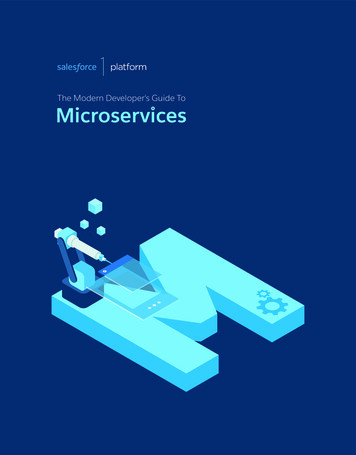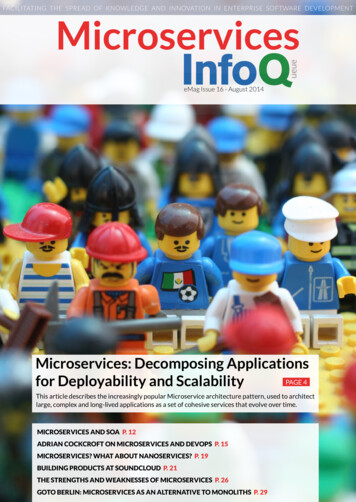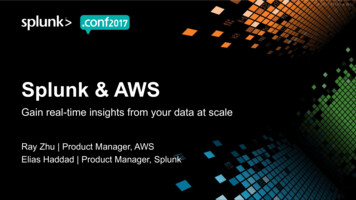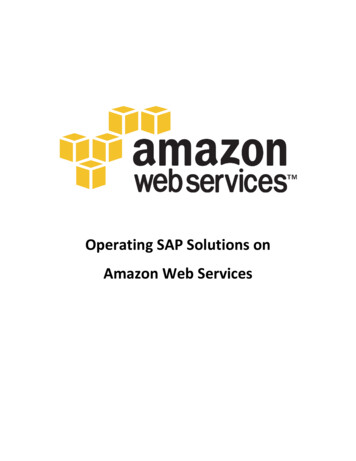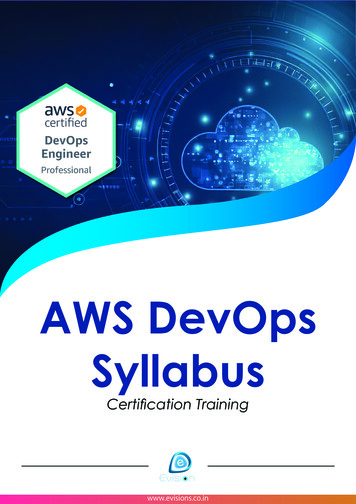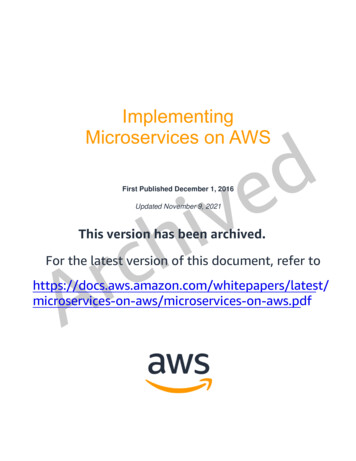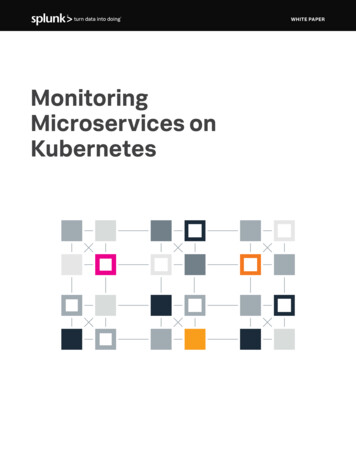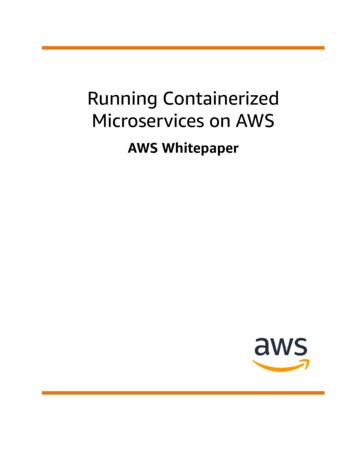
Transcription
Running ContainerizedMicroservices on AWSAWS Whitepaper
Running Containerized Microserviceson AWS AWS WhitepaperRunning Containerized Microservices on AWS: AWS WhitepaperCopyright Amazon Web Services, Inc. and/or its affiliates. All rights reserved.Amazon's trademarks and trade dress may not be used in connection with any product or service that is notAmazon's, in any manner that is likely to cause confusion among customers, or in any manner that disparages ordiscredits Amazon. All other trademarks not owned by Amazon are the property of their respective owners, who mayor may not be affiliated with, connected to, or sponsored by Amazon.
Running Containerized Microserviceson AWS AWS WhitepaperTable of ContentsAbstract . 1Abstract . 1Introduction . 2Componentization Via Services . 3Organized Around Business Capabilities . 5Products Not Projects . 7Smart Endpoints and Dumb Pipes . 8Decentralized Governance . 10Decentralized Data Management . 12Infrastructure Automation . 14Design for Failure . 16Evolutionary Design . 19Conclusion . 21Contributors . 22Document Revisions . 23Notices . 24iii
Running Containerized Microserviceson AWS AWS WhitepaperAbstractRunning Containerized Microserviceson AWSPublication date: August 5, 2021 (Document Revisions (p. 23))AbstractThis whitepaper is intended for architects and developers who want to run containerized applicationsat scale in production on Amazon Web Services (AWS). This document provides guidance for applicationlifecycle management, security, and architectural software design patterns for container-basedapplications on AWS.We also discuss architectural best practices for adoption of containers on AWS, and how traditionalsoftware design patterns evolve in the context of containers. We leverage Martin Fowler’s principles ofmicroservices and map them to the twelve-factor app pattern and real-life considerations. After readingthis paper, you will have a starting point for building microservices using best practices and softwaredesign patterns.1
Running Containerized Microserviceson AWS AWS WhitepaperIntroductionAs modern, microservices-based applications gain popularity, containers are an attractive building blockfor creating agile, scalable, and efficient microservices architectures. Whether you are considering alegacy system or a greenfield application for containers, there are well-known, proven software designpatterns that you can apply.Microservices are an architectural and organizational approach to software development in whichsoftware is composed of small, independent services that communicate to each other. There are differentways microservices can communicate, but the two commonly used protocols are HTTP request/responseover well-defined APIs, and lightweight asynchronous messaging . These services are owned by small,self-contained teams. Microservices architectures make applications easier to scale and faster to develop.This enables innovation and accelerates time-to-market for new features. Containers also provideisolation and packaging for software, and help you achieve more deployment velocity and resourcedensity.As proposed by Martin Fowler, the characteristics of a microservices architecture include the following: Componentization via services Organized around business capabilities Products not projects Smart endpoints and dumb pipes Decentralized governance Decentralized data management Infrastructure automation Design for failure Evolutionary designThese characteristics tell us how a microservices architecture is supposed to behave. To help achievethese characteristics, many development teams have adopted the twelve-factor app patternmethodology. The twelve factors are a set of best practices for building modern applications that areoptimized for cloud computing. The twelve factors cover four key areas: deployment, scale, portability,and architecture:1. Codebase - One codebase tracked in revision control, many deploys2. Dependencies - Explicitly declare and isolate dependencies3. Config - Store configurations in the environment4. Backing services - Treat backing services as attached resources5. Build, release, run - Strictly separate build and run stages6. Processes - Execute the app as one or more stateless processes7. Port binding - Export services via port binding8. Concurrency - Scale out via the process model9. Disposability - Maximize robustness with fast startup and graceful shutdown10.Dev/prod parity - Keep development, staging, and production as similar as possible11.Logs - Treat logs as event streams12.Admin processes - Run admin/management tasks as one-off processesAfter reading this whitepaper, you will know how to map the microservices design characteristics totwelve-factor app patterns, down to the design pattern to be implemented.2
Running Containerized Microserviceson AWS AWS WhitepaperComponentization Via ServicesIn a microservices architecture, software is composed of small independent services that communicateover well-defined APIs. These small components are divided so that each of them does one thing, anddoes it well, while cooperating to deliver a full-featured application. An analogy can be drawn to theWalkman portable audio cassette players that were popular in the 1980s: batteries bring power, audiotapes are the medium, headphones deliver output, while the main tape player takes input throughkey presses. Using them together plays music. Similarly, microservices need to be decoupled, and eachshould focus on one functionality. Additionally, a microservices architecture allows for replacement orupgrade. Using the Walkman analogy, if the headphones are worn out, you can replace them withoutreplacing the tape player. If an order management service in our store-keeping application is fallingbehind and performing too slowly, you can swap it for a more performant, more streamlined component.Such a permutation would not affect or interrupt other microservices in the system.Through modularization, microservices offer developers the freedom to design each feature as ablack box. That is, microservices hide the details of their complexity from other components. Anycommunication between services happens by using well-defined APIs to prevent implicit and hiddendependencies.Decoupling increases agility by removing the need for one development team to wait for anotherteam to finish work that the first team depends on. When containers are used, container images canbe swapped for other container images. These can be either different versions of the same image ordifferent images altogether—as long as the functionality and boundaries are conserved.Containerization is an operating-system-level virtualization method for deploying and runningdistributed applications without launching an entire virtual machine (VM) for each application. Containerimages allow for modularity in services. They are constructed by building functionality onto a baseimage. Developers, operations teams, and IT leaders should agree on base images that have the securityand tooling profile that they want. These images can then be shared throughout the organization as theinitial building block. Replacing or upgrading these base images is as simple as updating the FROM fieldin a Dockerfile and rebuilding, usually through a Continuous Integration/Continuous Delivery (CI/CD)pipeline.Here are the key factors from the twelve-factor app pattern methodology that play a role incomponentization: Dependencies (explicitly declare and isolate dependencies) – Dependencies are self-contained withinthe container and not shared with other services. Disposability (maximize robustness with fast startup and graceful shutdown) – Disposability isleveraged and satisfied by containers that are easily pulled from a repository and discarded when theystop running. Concurrency (scale out via the process model) – Concurrency consists of tasks or pods (made ofcontainers working together) that can be auto scaled in a memory- and CPU-efficient manner.As each business function is implemented as its own service, the number of containerized servicesgrows. Each service should have its own integration and its own deployment pipeline. This increasesagility. Because containerized services are subject to frequent deployments, you need to introduce acoordination layer that tracks which containers are running on which hosts. Eventually, you will want asystem that provides the state of containers, the resources available in a cluster, etc.Container orchestration and scheduling systems allow you to define applications, by assembling a setof containers that work together. You can think of the definition as the blueprint for your applications.You can specify various parameters, such as which containers to use and which repositories they belong3
Running Containerized Microserviceson AWS AWS Whitepaperin, which ports should be opened on the container instance for the application, and what data volumesshould be mounted.Container management systems allow you to run and maintain a specified number of instances of acontainer set—containers that are instantiated together and collaborate using links or volumes. AmazonECS refers to these as Tasks, Kubernetes refers to them as Pods. Schedulers maintain the desired count ofcontainer sets for the service. Additionally, the service infrastructure can be run behind a load balancerto distribute traffic across the container set associated with the service.4
Running Containerized Microserviceson AWS AWS WhitepaperOrganized Around BusinessCapabilitiesDefining exactly what constitutes a microservice is very important for development teams to agree on.What are its boundaries? Is an application a microservice? Is a shared library a microservice?Before microservices, system architecture would be organized around technological capabilities suchas user interface, database, and server-side logic. In a microservices-based approach, as a best practice,each development team owns the lifecycle of its service all the way to the customer. For example, arecommendations team might own development, deployment, production support, and collection ofcustomer feedback.In a microservices-driven organization, small teams act autonomously to build, deploy, and managecode in production. This allows teams to work at their own pace to deliver features. Responsibilityand accountability foster a culture of ownership, allowing teams to better align to the goals of theirorganization and be more productive.Microservices are as much an organizational attitude as a technological approach. This principle is knownas Conway's Law:"Organizations which design systems . are constrained to produce designs which are copies ofthe communication structures of these organizations." — M. ConwayWhen architecture and capabilities are organized around atomic business functions, dependenciesbetween components are loosely coupled. As long as there is a communication contract between servicesand teams, each team can run at its own speed. With this approach, the stack can be polyglot, meaningthat developers are free to use the programming languages that are optimal for their component.For example, the user interface can be written in JavaScript or HTML5, the backend in Java, and dataprocessing can be done in Python.This means that business functions can drive development decisions. Organizing around capabilitiesmeans that each API team owns the function, data, and performance completely.The following are key factors from the twelve-factor app pattern methodology that play a role inorganizing around capabilities: Codebase (one codebase tracked in revision control, many deploys) –Each microservice owns its owncodebase in a separate repository and throughout the lifecycle of the code change. Build, release, run (strictly separate build and run stages) – Each microservice has its own deploymentpipeline and deployment frequency. This allows the development teams to run microservices atvarying speeds so they can be responsive to customer needs. Processes (execute the app as one or more stateless processes) – Each microservice does one thing anddoes that one thing really well. The microservice is designed to solve the problem at hand in the bestpossible manner. Admin processes (run admin/management tasks as one-off processes) – Each microservice has its ownadministrative or management tasks so that it functions as designed.To achieve a microservices architecture that is organized around business capabilities, use popularmicroservices design patterns. A design pattern is a general, reusable solution to a commonly occurringproblem within a giving context.Popular miscroservice design patterns include:5
Running Containerized Microserviceson AWS AWS Whitepaper Aggregator Pattern – A basic service which invokes other services to gather the required informationor achieve the required functionality. This is beneficial when you need an output by combining datafrom multiple microservices. API Gateway Design Pattern – API Gateway also acts as the entry point for all the microservices andcreates fine-grained APIs for different types of clients. It can fan out the same request to multiplemicroservices and similarly aggregate the results from multiple microservices. Chained or Chain of Responsibility Pattern – Chained or Chain of Responsibility Design Patternsproduces a single output which is a combination of multiple chained outputs. object. Asynchronous Messaging Design Pattern – In this type of microservices design pattern, all theservices can communicate with each other, but they do not have to communicate with each othersequentially and they usually communicate asynchronously. Database or Shared Data Pattern – This design pattern will enable you to use a database per serviceand a shared database per service to solve various problems. These problems can include duplicationof data and inconsistency, different services have different kinds of storage requirements, few businesstransactions can query the data, and with multiple services and de-normalization of data. Event Sourcing Design Pattern – This design pattern helps you to create events according to changeof your application state. Command Query Responsibility Segregator (CQRS) Design Pattern – This design pattern enablesyou to divide the command and query. Using the common CQRS pattern, where the command part willhandle all the requests related to CREATE, UPDATE, DELETE while the query part will take care of thematerialized views. Circuit Breaker Pattern – This design pattern enables you to stop the process of the request andresponse when the service is not working. For example, when you need to redirect the request to adifferent service after certain number of failed request intents. Decomposition Design Pattern – This design pattern enables you to decompose an application basedon business capability or on based on the sub-domains.6
Running Containerized Microserviceson AWS AWS WhitepaperProducts Not ProjectsCompanies that have mature applications with successful software adoption and who want to maintainand expand their user base will likely be more successful if they focus on the experience for theircustomers and end users.To stay healthy, simplify operations, and increase efficiency, your engineering organization should treatsoftware components as products that can be iteratively improved and that are constantly evolving.This is in contrast to the strategy of treating software as a project, which is completed by a team ofengineers and then handed off to an operations team that is responsible for running it. When softwarearchitecture is broken into small microservices, it becomes possible for each microservice to be anindividual product. For internal microservices, the end user of the product is another team or service. Foran external microservice, the end user is the customer.The core benefit of treating software as a product is improved end-user experience. When yourorganization treats its software as an always-improving product rather than a one-off project, it willproduce code that is better architected for future work. Rather than taking shortcuts that will causeproblems in the future, engineers will plan software so that they can continue to maintain it in the longrun. Software planned in this way is easier to operate, maintain, and extend. Your customers appreciatesuch dependable software because they can trust it.Additionally, when engineers are responsible for building, delivering, and running software they gainmore visibility into how their software is performing in real-world scenarios, which accelerates thefeedback loop. This makes it easier to improve the software or fix issues.The following are key factors from the twelve-factor app pattern methodology that play a role inadopting a product mindset for delivering software: Build, release, run – Engineers adopt a devops culture that allows them to optimize all three stages. Config – Engineers build better configuration management for software due to their involvement withhow that software is used by the customer. Dev/prod parity – Software treated as a product can be iteratively developed in smaller pieces thattake less time to complete and deploy than long-running projects, which enables development andproduction to be closer in parity.Adopting a product mindset is driven by culture and process—two factors that drive change. The goalof your organization’s engineering team should be to break down any walls between the engineers whobuild the code and the engineers who run the code in production. The following concepts are crucial: Automated provisioning – Operations should be automated rather than manual. This increasesvelocity as well as integrates engineering and operations. Self-service – Engineers should be able to configure and provision their own dependencies. This isenabled by containerized environments that allow engineers to build their own container that hasanything they require. Continuous Integration – Engineers should check in code frequently so that incrementalimprovements are available for review and testing as quickly as possible. Continuous Build and Delivery – The process of building code that’s been checked in and delivering itto production should be automated so that engineers can release code without manual intervention.Containerized microservices help engineering organizations implement these best practice patterns bycreating a standardized format for software delivery that allows automation to be built easily and usedacross a variety of different environments, including local, quality assurance, and production.7
Running Containerized Microserviceson AWS AWS WhitepaperSmart Endpoints and Dumb PipesAs your engineering organization transitions from building monolithic architectures to buildingmicroservices architectures, it will need to understand how to enable communications betweenmicroservices. In a monolith, the various components are all in the same process. In a microservicesenvironment, components are separated by hard boundaries. At scale, a microservices environmentwill often have the various components distributed across a cluster of servers so that they are not evennecessarily collocated on the same server.This means there are two primary forms of communication between services: Request/Response – One service explicitly invokes another service by making a request to either storedata in it or retrieve data from it. For example, when a new user creates an account, the user servicemakes a request to the billing service to pass off the billing address from the user’s profile so that thatbilling service can store it. Publish/Subscribe – Event-based architecture where one service implicitly invokes another servicethat was watching for an event. For example, when a new user creates an account, the user servicepublishes this new user signup event and the email service that was watching for it is triggered toemail the user asking them to verify their email.One architectural pitfall that generally leads to issues later on is attempting to solve communicationrequirements by building your own complex enterprise service bus for routing messages betweenmicroservices. It is much better to use a message broker such as Amazon MSK, or Amazon SimpleNotification Service (Amazon SNS) and Amazon Simple Queue Service (Amazon SQS). Microservicesarchitectures favor these tools because they enable a decentralized approach in which the endpoints thatproduce and consume messages are smart, but the pipe between the endpoints is dumb. In other words,concentrate the logic in the containers and refrain from leveraging (and coupling to) sophisticated busesand messaging services.Network communication often plays a central role in distributed systems. Service meshes strive toaddress this issue. Here you can leverage the idea of externalizing selected functionalities. Servicemeshes work on a sidecar pattern where you add containers to extend the behavior of existingcontainers. Sidecar is a microservices design pattern where a companion service runs next to yourprimary microservice, augmenting its abilities or intercepting resources it is utilizing. Envoy, a sidecarcontainer, is used with AWS App Mesh as a proxy for all ingress and egress traffic to the primarymicroservice. Using this sidecar pattern with Envoy you can create the backbone of the service mesh,without impacting our applications, a service mesh is comprised of a control plane and a data plane. Incurrent implementations of service meshes, the data plane is made up of proxies sitting next to yourapplications or services, intercepting any network traffic that is under the management of the proxies.Envoy can be used as a communication bus for all traffic internal to a service-oriented architecture (SOA).Sidecars can also be used to build monitoring solutions. When you are running microservices usingKubernetes, there are multiple observability strategies, one of them is using sidecars. Due to the modularnature of the sidecars, you can use it for your logging and monitoring needs. For example, you cansetup FluentBit or Firelens for Amazon ECS to send logs from containers to Amazon CloudWatch Logs.AWS Distro for Open Telemetry can also be used for gathering metrics and sending metrics off toother services. Recently AWS has launched managed Prometheus and Grafana for the monitoring/visualization use cases.The core benefit of building smart endpoints and dumb pipes is the ability to decentralize thearchitecture, particularly when it comes to how endpoints are maintained, updated, and extended.One goal of microservices is to enable parallel work on different edges of the architecture that will notconflict with each other. Building dumb pipes enables each microservice to encapsulate its own logic forformatting its outgoing responses or supplementing its incoming requests.8
Running Containerized Microserviceson AWS AWS WhitepaperThe following are the key factors from the twelve-factor app pattern methodology that play a role inbuilding smart endpoints and dumb pipes: Port Binding – Services bind to a port to watch for incoming requests and send requests to the port ofanother service. The pipe in between is just a dumb network protocol such as HTTP. Backing services – Dumb pipes allow a background microservice to be attached to anothermicroservice in the same way that you attach a database. Concurrency – A properly designed communication pipeline between microservices allows multiplemicroservices to work concurrently. For example, several observer microservices may respond andbegin work in parallel in response to a single event produced by another microservice.9
Running Containerized Microserviceson AWS AWS WhitepaperDecentralized GovernanceAs your organization grows and establishes more code-driven business processes, one challenge it couldface is the necessity to scale the engineering team and enable it to work efficiently in parallel on a largeand diverse codebase. Additionally, your engineering organization will want to solve problems using thebest available tools.Decentralized governance is an approach that works well alongside microservices to enable engineeringorganizations to tackle this challenge. Traffic lights are a great example of decentralized governance. Citytraffic lights may be timed individually or in small groups, or they may react to sensors in the pavement.However, for the city as a whole, there is no need for a primary traffic control center in order to keepcars moving. Separately implemented local optimizations work together to provide a city-wide solution.Decentralized governance helps remove potential bottlenecks that would prevent engineers from beingable to develop the best code to solve business problems.When a team kicks off its first greenfield project it is generally just a small team of a few people workingtogether on a common codebase. After the greenfield project has been completed, the business willquickly discover opportunities to expand on their first version. Customer feedback generates ideasfor new features to add and ways to expand the functionality of existing features. During this phase,engineers will start growing the codebase and your organization will start dividing the engineeringorganization into service-focused teams.Decentralized governance means that each team can use its expertise to choose the best tools to solvetheir specific problem. Forcing all teams to use the same database, or the same runtime language, isn’treasonable because the problems they’re solving aren’t uniform. However, decentralized governance isnot without boundaries. It is helpful to use standards throughout the organization, such as a standardbuild and code review process because this helps each team continue to function together.Source control plays an important role in the decentralized governance. Git can be used as a sourceof truth to operate the deployment and governance strategies. For example, version control, history,peer review and rollback can happen through Git without needing to use additional tools. With GitOps,automated delivery pipelines roll out changes to your infrastructure when changes are made by pullrequest to Git. GitOps also makes use of tools that compares the production state of your applicationwith what’s under source control and alerts you if your running cluster doesn’t match your desired state.The following are the principles for GitOps to work in practice:1. Your entire system described declaratively2. A desired system state version controlled in Git3. The ability for changes to be automatically applied4. Software agents that verify correct system state and alert on divergenceMost CI/CD tools available today use a push-based model. A push-based pipeline means that code startswith the CI system and then continues its path through a series of encoded scripts in your CD system topush changes to the destination. The reason you don’t want to use your CI/CD system as the basis foryour deployments is because of the potential to expose credentials outside of your cluster. While it ispossible to secure your CI/CD scripts, you are still working outside the trust domain of your cluster whichis not recommended. With a pipeline that pulls an image from the repository, your cluster credentials arenot exposed outside of your production environment.The following are the key factors from the twelve-factor app pattern methodology that play a role inenabling decentralized governance:10
Running Containerized Microserviceson AWS AWS Whitepaper Dependencies – Decentralized governance allows teams to choose their own dependencies, sodependency isolation is critical to make this work properly. Build, release, run – Decentralized governance should allow teams with different build processes touse their own toolchains, yet should allow releasing and running the code to be seamless, even withdiffering underlying build tools. Backing services – If each consumed resource
from multiple microservices. API Gateway Design Pattern - API Gateway also acts as the entry point for all the microservices and creates fine-grained APIs for different types of clients. It can fan out the same request to multiple microservices and similarly aggregate the results from multiple microservices.

